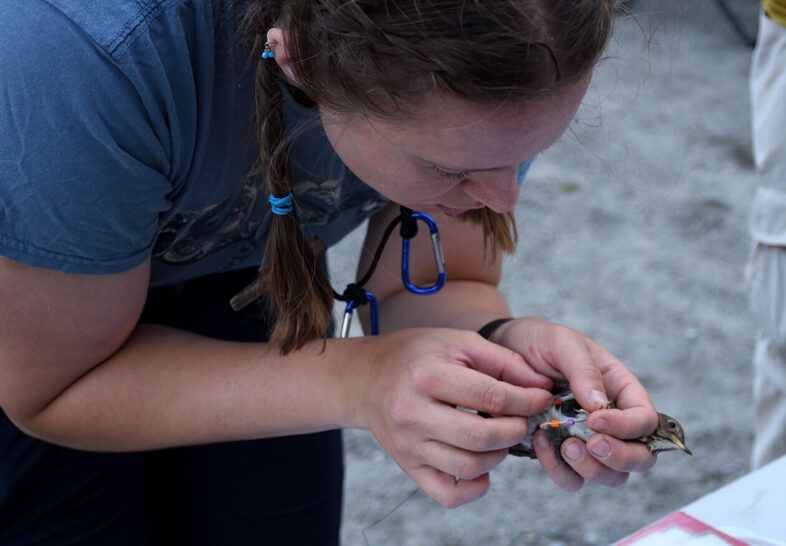
Anna attaches color bands to a Bicknell’s Thrush. All banding, marking, and sampling is being conducted under a federally authorized Bird Banding Permit issued by the U.S. Geological Survey’s BBL. © Michael Sargent
With six trips up to Mount Mansfield’s peak and five trips to Mount Washington under our belts, VCE’s banding team is well into our summer 2024 montane bird banding and monitoring efforts! Battling rain, wind, chill, and scorching heat has been the baseline for this summer, but although perfect weather has been elusive, the birds we seek have not.
In only six visits to Mount Mansfield, the VCE team has captured 376 birds at our mountaintop banding station, 234 of which were entirely new (previously untagged) individuals. This total includes:
- 30 new Bicknell’s Thrushes
- 14 new Swainson’s Thrushes
- 31 new Blackpoll Warblers
- 30 new Myrtle Warblers
- 38 new Slate-colored Juncos
- 16 new White-Throated Sparrows
In addition to our focal species, we’ve also caught a few surprises this summer, like Pine Siskins, a White-winged Crossbill, and a Sharp-shinned Hawk! Needless to say, we’ve been tremendously busy but having lots of fun as well.
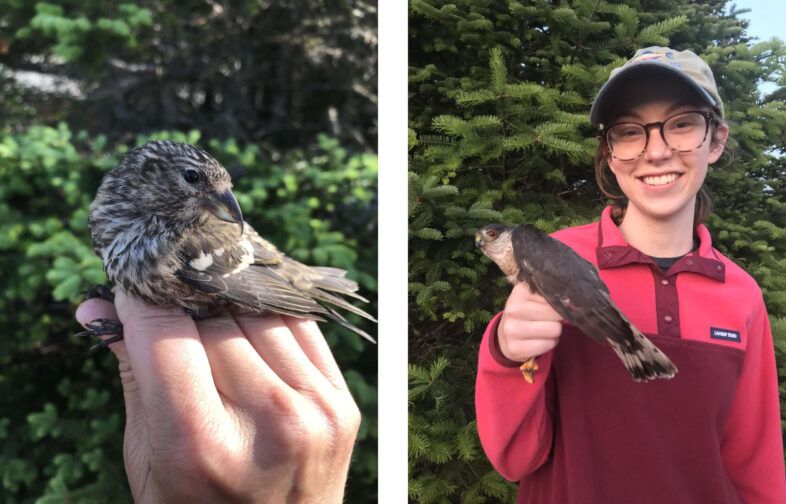
Left: White-winged Crossbill; Right: VCE Summer Field Ecology Intern Zoey Pickett holds a Sharp-shinned Hawk. All banding, marking, and sampling is being conducted under a federally authorized Bird Banding Permit issued by the U.S. Geological Survey’s BBL. © Kevin Dernier
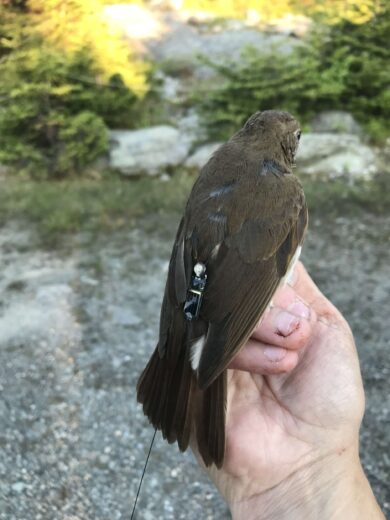
A female Bicknell’s Thrush sports her new solar-powered motus transmitter. All banding, marking, and sampling is being conducted under a federally authorized Bird Banding Permit issued by the U.S. Geological Survey’s BBL. © Desirée Narango
However, the real highlight of these visits has been deploying new Motus transmitters and geolocator tags. This summer marked the first year of deploying solar-powered Motus transmitters on female Bicknell’s Thrush to track their survival and migration throughout the year. We began the season with the hope of tagging as many female Bicknell’s Thrush as possible, with the knowledge that female capture rates have historically been low due to the male-biased sex ratio in this species. In 2023, VCE’s team only captured 10 female Bicknell’s Thrush, making our task daunting. But luck was in our favor this year; on July 9, we gave our 14th female Bicknell’s Thrush capture of 2024 her Motus transmitter! Each of these birds carries with it our hopes of learning more about female conservation in this species, bringing us one step closer to a complete picture of Bicknell’s Thrush—a picture that for too long has been shaped mainly by observations of the easier-to-detect and easier-to-catch males.
This year also marked the start of a new collaboration with National Audubon on Blackpoll Warblers. You may remember that VCE collaborated with Audubon scientist Bill Deluca way back in 2013–2014 to first document that our Mansfield Blackpoll Warblers undertake an epic transatlantic flight on their way to South America. We’re partnering with Deluca again, using archival geolocators that can track not just where birds are flying but also how high and fast. So far, we’ve deployed 10 geolocators on Blackpoll Warblers, crossing our fingers that these tiny birds return to our nets next year with precise information on the altitude of their migratory flights over the Atlantic. This information will help us better understand what kind of risks offshore wind farms might have for this species while crossing the ocean. More on this new work soon!
By contrast, VCE’s time on Mount Washington has been much more targeted. In five visits, we have banded 15 Bicknell’s Thrush, of which 12 of these birds left our hands bearing brand-new Motus transmitters. Fifteen may seem small compared to the 30 captured on Mansfield; however, netting birds on Washington is a much different experience than on Mansfield. Each time we go to Washington, we must set up nets from scratch in totally new locations. In contrast, each of our nets on Mansfield has established trails to use, with poles and strings already in place—all we need to do is attach the nets, and we’re ready to begin catching birds. Mount Washington’s famously ferocious weather makes our task even more difficult. We have battled wind on almost every visit, with one wild night buffeting us with winds of up to 85 kmh (52 mph) while we tried to catch a few hours of sleep! Despite these conditions, we have braved the mountain, keeping VCE staff and bird safety in mind, and are incredibly proud of the data we’ve collected.
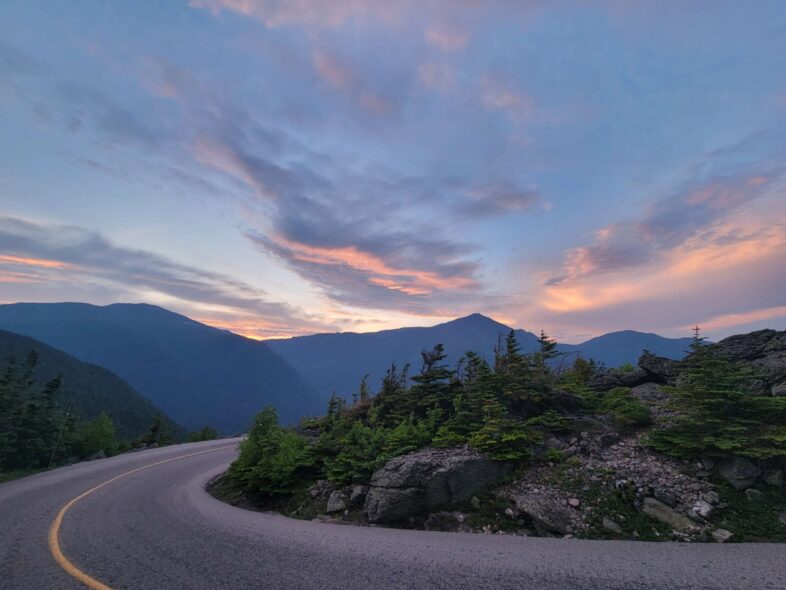
Sunset from the Mount Washington Toll Road © Anna Peel
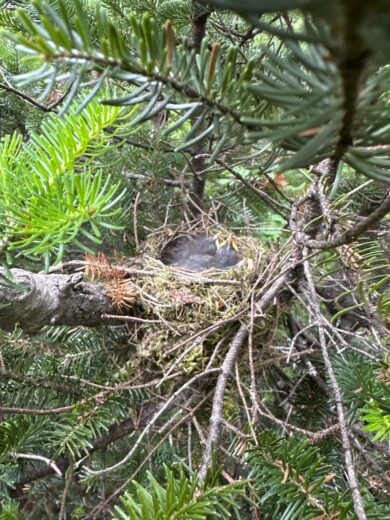
Wilma’s nest © Kevin Dernier
Although VCE’s primary goal in putting out transmitters is to track these birds’ migratory movements, VCE’s graduate intern, Kevin Dernier, has also seized the opportunity to follow our female Bicknell’s Thrushes in a much more granular manner. Using a hand-held radio receiver, he has spent many hours tracking our tagged females all over Mansfield, hoping to find their nests. Just this past week, his efforts paid off! For three visits to Mansfield, he had tracked one particular female—so dubbed “Wilma”—back and forth across the beginning of the Amherst trail, zeroing in on a thicket of Balsam Fir as the most likely nest location due to it receiving the most regular concentration of Motus transmitter “pings.” A final pass revealed that Wilma had chosen a well-concealed notch in a short Balsam Fir on the edge of the thicket for her nest. The full-body satisfaction of investigating what seems like yet another dense, dark, twiggy cluster on a tree only to find a cup full of yellow-lined begging mouths cannot be rivaled. Although finding Bicknell’s Thrush nests will never be easy, we’re excited about the opportunity these Motus transmitters give us to narrow in on where their nests are more efficiently. Congratulations to Kevin on finding his first Bicknell’s Thrush nest—may there be many more to come!

So glad your continuing the Mountain Birdwatch program. Great to hear of the many new fledged birds too. Continue the good work.
Thanks for the update on Bicknell’s.
It is exciting to learn of what is happening on the roof of Vermont!
Hip hip hooray! Thank you so much for my day spent with you up on Mansfield! Fantastic work you guys.